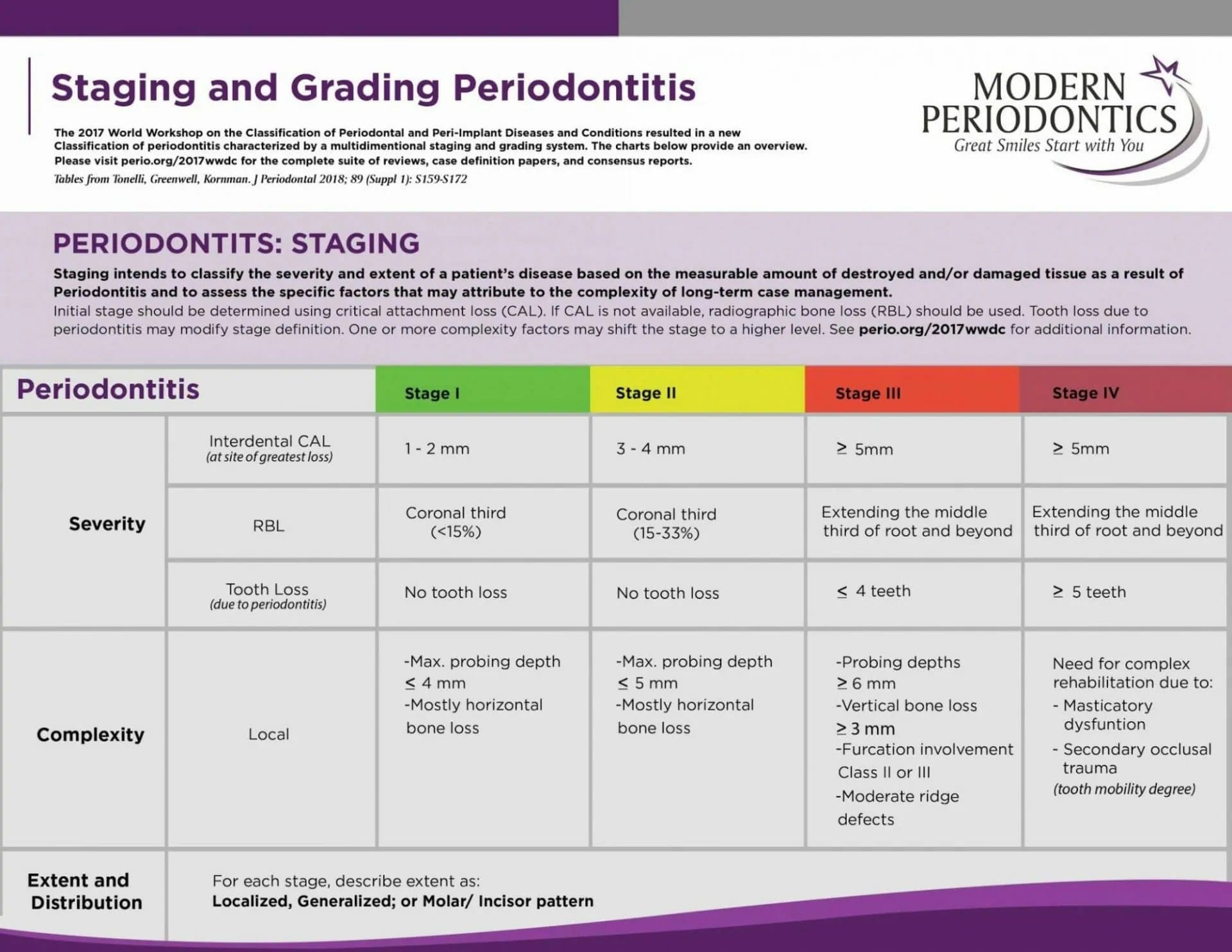Periodontitis, commonly known as gum disease, is a chronic inflammatory condition affecting the tissues supporting your teeth. Left untreated, it can lead to tooth loss and other serious health complications. Understanding the severity and potential progression of periodontitis is crucial for effective treatment. This is where staging and grading come in. These systems provide a framework for classifying the disease, allowing dental professionals to develop personalized treatment plans and predict long-term outcomes.
Staging: Assessing the Extent of Damage
Staging periodontitis focuses on evaluating the current extent of the damage caused by the disease. It’s like assessing the damage after a flood—how high did the water rise, and how much was affected? We use several key measurements to determine the stage, including clinical attachment loss (CAL), probing depth (PD), bone loss, and tooth loss. [https://www.lolaapp.com/]
-
Stage I (Initial Periodontitis): This is the earliest stage, characterized by minor gum inflammation and slight bone loss. Probing depths may range from 4-5 mm, and there’s minimal attachment loss (1-2 mm). Think of it as a small leak—easily manageable if addressed promptly.
-
Stage II (Moderate Periodontitis): The disease progresses in this stage, with increased inflammation, deeper probing depths (5-6 mm), more attachment loss (3-4 mm), and noticeable bone loss. This stage might be comparable to a burst pipe—requiring more significant intervention.
-
Stage III (Severe Periodontitis): This stage marks significant damage. There’s substantial bone loss (often 5mm or more), increased attachment loss (5mm or more), deeper pockets (6mm or greater), and potential for tooth loss (up to four teeth). At this stage, the “flood” has caused substantial damage and requires extensive repairs. Furcation involvement, where the bone loss extends to the roots of multi-rooted teeth, is also possible.
-
Stage IV (Advanced Periodontitis): This is the most advanced stage, characterized by major bone loss and significant tooth loss (five or more teeth). Chewing function may be compromised, and there may be noticeable changes in the appearance of your smile. This represents severe “flood damage,” requiring extensive and ongoing management. [https://www.lolaapp.com/stobys-menu]
Grading: Predicting the Pace of Progression
While staging looks at the present state of the disease, grading attempts to predict its future course. It takes into account risk factors that may influence how quickly the disease is likely to progress. This is akin to assessing the weather forecast—are conditions favorable for a storm to intensify?
-
Grade A (Slow Progression): This suggests a slow rate of progression with minimal risk factors. The “forecast” is relatively calm. Patients in this grade may demonstrate good oral hygiene and have no systemic conditions like diabetes that could exacerbate periodontitis.
-
Grade B (Moderate Progression): This grade indicates a moderate rate of progression and the presence of some risk factors, such as smoking or poorly controlled diabetes. The “forecast” suggests some potential for increased storm activity.
-
Grade C (Rapid Progression): This signifies a rapid rate of progression and the presence of multiple risk factors. The “forecast” points towards a high likelihood of rapid disease advancement. This grade may indicate a compromised immune system or severe inflammation. [https://www.lolaapp.com/spectrum-leader-poe]
Implications for Treatment
Staging and grading together play a vital role in determining the appropriate course of treatment.
-
Treatment Planning: Early stages (I and II) may respond well to non-surgical therapies like scaling and root planing (a deep cleaning procedure). More advanced stages (III and IV) often require surgical interventions, such as flap surgery or bone grafting, to repair the damage and prevent further progression.
-
Prognosis: The stage and grade also influence the long-term prognosis. Higher stages and grades suggest a more aggressive disease course and a higher risk of tooth loss and other complications.
Patient Involvement: Your Role in Gum Health
Understanding your stage and grade of periodontitis empowers you to actively participate in your treatment decisions. It allows for more productive conversations with your dentist about your options, expected outcomes, and long-term maintenance.
Dr. Mayank Saxena MBBS (1.5 years of exp) states, “Staging is determined based on the extent of disease and includes factors such as clinical attachment loss, probing depth, bone loss, and tooth loss due to periodontitis… Grading… is based on the assessment of risk factors and the rate of disease progression.” This highlights the comprehensive nature of the assessment, going beyond simply examining the gums to include factors that influence long-term outcomes.
Conclusion
Staging and grading provide a comprehensive picture of your periodontal health, enabling your dentist to tailor a personalized treatment plan. While research is ongoing and our understanding of periodontitis continues to evolve, including the possibility of genetic influences, accurate staging and grading are essential tools for personalized care and improved outcomes. Remember, this information is for educational purposes and should not replace a professional evaluation by your dentist. Regular checkups are crucial for monitoring your periodontal health and ensuring long-term success.
















